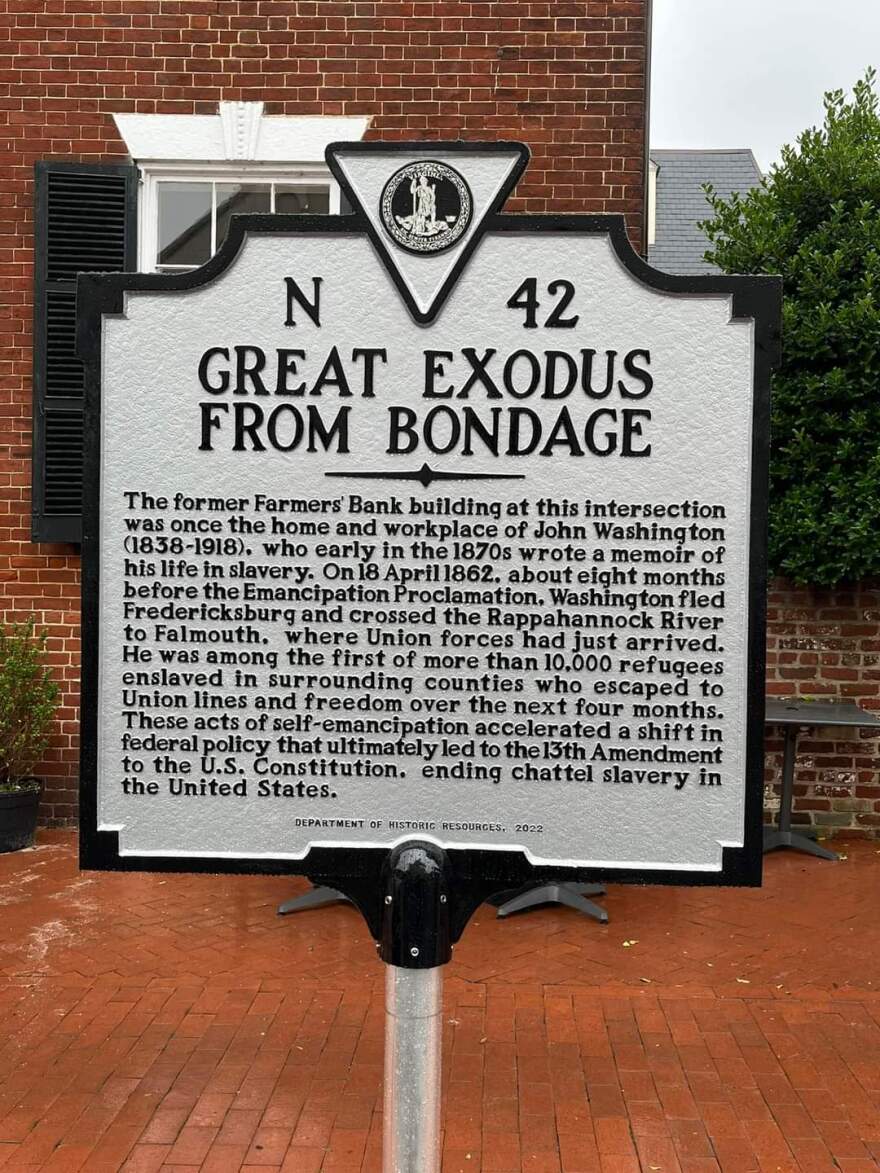Editor’s note: Chris Williams is a member of VPM’s community advisory board.
A few days after Juneteenth, the Fredericksburg Civil Rights Trail revealed a new historical marker. It tells the story of a formerly enslaved person, John Washington, and approximately 10,000 others who escaped slavery during the Civil War. All of those who are honored emancipated themselves in 1862 by crossing the Rappahannock River to Union lines.
“The spring and summer of 1862, before the first battle of Fredericksburg when the Union troops occupied the city of Fredericksburg ... so many of the enslaved people left their owners and that property to seize their freedom by walking across the Rappahannock River,” said Chris Williams, associate director of the James Farmer Multicultural Center.
The marker, titled "Great Exodus from Bondage," is the ninth stop on the trail that opened in February. It stands proud in front of the restaurant Foode, referencing its history as the Farmers Bank of Virginia and the home of John Washington, who lived on the second floor.

In 2021, Williams met with Christine Henry, chair of the Historic Preservation Department at UMW, and historian John Hennessy at Old Mill Park — the very place where Washington gained freedom — and learned his story.
John Washington “is the only enslaved person’s account that we have, who was enslaved in the city of Fredericksburg,” Williams said. “He wrote his memoirs 11 years after his freedom in 1873.”
According to Encyclopedia Virginia, Washington was born in 1838 to the enslaved Sarah Tucker. Tucker taught him how to spell during their time laboring on a farm before Washington became a personal servant, living with his enslaver at the Farmers Bank. Many pictures of Washington were shown at the marker’s dedication, and his life was detailed.
Following his departure, the building he’d been enslaved in became a Freedmen’s Bureau — dedicated to the integration of former enslaved African Americans into society, offering them various means of support.
Washington authored his memoir, Memorys of the Past, and worked for Baptist churches in Washington, D.C. He died in Cohasset, Massachusetts, in 1918.

Williams told VPM News that the trail was created to “embark on an effort where we told the city's Black history in a comprehensive way.”
“Where we were lacking in the city of Fredericksburg is telling the full story of not only just the Civil Rights movement, but of the Black history of this area,” Williams said. “Fredericksburg in the 1850s was considered one of the best places to sell enslaved people in the state of Virginia.”
The trail is spearheaded by Williams and Victoria Matthews, who works for the city’s tourism office. In September, they were notified by the Virginia Department of Historic Resources that "Great Exodus from Bondage" was selected to become an official historic marker.
To Williams, the life of John Washington and those who fled across the Rappahannock River will inform current and future generations:
“John Washington’s story is necessary to understand the complexities of this country's history, how far we've come, and how far we have to go still,” Williams said.
There are plans to expand the Fredericksburg Civil Rights Trail onto the University of Mary Washington campus, telling a second part of the story in the form of four wayside panels.
“I don't want the next generation or the generation after that to [walk] through these same streets not knowing their history," Williams said. “I'm not just talking about Black children, I'm talking about all children, the city of Fredericksburg and surrounding counties. This is a history that they need to know and to understand.”



